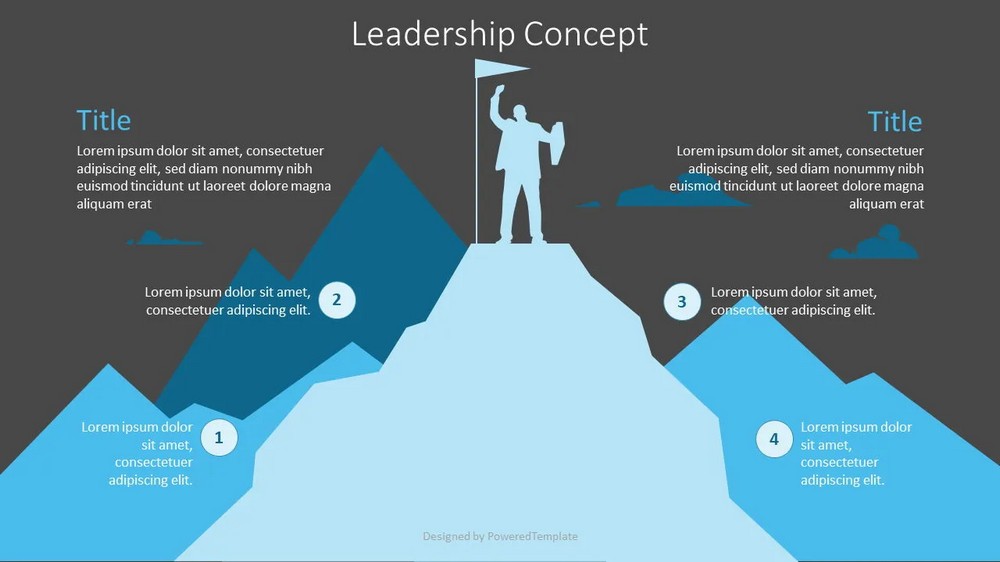This article explores the critical role of leadership and vision in successful business management. It delves into how effective leadership and a compelling vision can drive business success, inspire teams, and navigate through the ever-changing landscape of the corporate world.
With this text, we continue a series of eight articles dedicated to business management.
Accompanying this article are examples of presentation templates from the PoweredTemplate library, which serve as visual aids to help illustrate key concepts and ideas related to leadership and vision in business management. They provide a valuable resource for business professionals seeking to enhance their presentations and effectively convey the importance of these pillars to their teams and stakeholders.
Table of Contents
- Role of Leadership and Vision in Driving Business Success
- Understanding Leadership
- The Power of Vision
- Leadership and Vision in Business Management
- Leading Change and Adaptation
- Strategies for Developing Leadership and Vision
- Conclusion
Role of Leadership and Vision in Driving Business Success
Leadership and vision play a pivotal role in driving business success. When combined effectively, they provide a strong foundation for organizations to thrive in today’s competitive landscape. Let’s explore the specific ways in which leadership and vision contribute to achieving positive outcomes in business management.

Leadership is the driving force behind a company’s direction, culture, and growth. Effective leaders inspire and motivate their teams, foster innovation, and make strategic decisions that steer the organization towards its goals. By setting a clear vision and creating a sense of purpose, leaders provide a roadmap for success and align the efforts of their teams.
Vision, on the other hand, provides the long-term perspective and aspiration that fuels an organization’s growth. A compelling vision paints a vivid picture of what the company aims to achieve and inspires stakeholders to work towards a shared goal. It serves as a guiding light, helping employees understand the purpose behind their work and fostering a sense of belonging and commitment.
When leadership and vision are in sync, remarkable things happen. Here are some key ways in which they drive business success:
- Strategic Alignment: Effective leaders use their vision to define and align the strategic direction of the organization. They ensure that all business activities and initiatives are in line with the overarching vision, enabling teams to work cohesively towards a common objective.
- Engaged Stakeholders: Leaders who effectively communicate the vision to stakeholders foster a sense of engagement and ownership. By clearly articulating the purpose and benefits of the vision, leaders inspire employees, customers, investors, and partners to actively contribute to the organization’s success.
- Adaptive Agility: In a rapidly changing business landscape, leaders with a clear vision can guide their organizations through uncertainty and complexity. By anticipating industry trends and proactively adapting strategies, leaders enable their companies to stay ahead of the curve and seize opportunities for growth.
- High-Performing Teams: Leadership that focuses on building and empowering high-performing teams creates an environment where individuals are motivated to excel. By fostering a culture of collaboration, trust, and accountability, leaders enable teams to unleash their full potential and drive business results.
- Innovation and Risk-Taking: A strong vision encourages innovation and risk-taking within an organization. Leaders who promote a culture of creativity and experimentation empower employees to think outside the box, challenge the status quo, and drive innovation that propels the company forward.
In summary, leadership and vision are inseparable components of successful business management. Effective leaders leverage their vision to set strategic direction, engage stakeholders, and empower teams to achieve extraordinary results. By embracing leadership and vision as key pillars of their management approach, businesses can navigate challenges, seize opportunities, and achieve sustainable success in an ever-evolving marketplace.
Understanding Leadership
Leadership is a multifaceted concept that plays a critical role in business management. To comprehend its significance, it is essential to explore the definition of leadership, examine the key traits and qualities of effective leaders, and understand the impact of different leadership styles on business management.
Definition of leadership

Leadership can be defined as the ability to influence and guide others toward a common goal or vision. It encompasses the skills, qualities, and behaviors that enable individuals to inspire and motivate their teams to achieve desired outcomes. Effective leaders not only provide direction but also empower and support their followers, fostering an environment of collaboration and growth. Through their influence, leaders shape the culture, values, and trajectory of an organization, driving it toward success.
Key traits and qualities of effective leaders
Effective leaders possess a range of traits and qualities that set them apart. These include:
- Visionary Thinking: Leaders have the ability to envision the future and articulate a compelling vision that inspires others.
- Emotional Intelligence: Leaders understand and manage their own emotions and effectively navigate the emotions of others. They are empathetic, self-aware, and skilled in building positive relationships.
- Communication Skills: Leaders excel in both verbal and non-verbal communication. They can convey their ideas clearly, listen actively, and adapt their communication style to different audiences.
- Integrity and Ethics: Leaders demonstrate high ethical standards and act with integrity. They earn the trust and respect of their teams by being honest, transparent, and fair.
- Decisiveness: Leaders make informed decisions in a timely manner. They gather relevant information, weigh options, and take decisive action when necessary.
- Adaptability: Leaders embrace change and possess the flexibility to navigate through uncertainty. They adjust their strategies and approaches as circumstances evolve.
- Resilience: Leaders exhibit resilience in the face of challenges and setbacks. They maintain a positive attitude, learn from failures, and persevere towards their goals.

Different leadership styles and their impact on business management
Leadership styles vary, and each has a distinct impact on business management. Some common leadership styles include:
- Transformational Leadership: Transformational leaders inspire and motivate their teams to exceed expectations. They encourage innovation, foster personal growth, and create a supportive work environment.
- Autocratic Leadership: Autocratic leaders make decisions independently and exert control over their teams. While this style can be effective in certain situations requiring quick decisions, it may limit creativity and collaboration.
- Democratic Leadership: Democratic leaders involve their teams in decision-making processes, valuing their input and fostering a sense of ownership. This style promotes collaboration and can lead to higher employee satisfaction and engagement.
- Laissez-Faire Leadership: Laissez-faire leaders provide minimal guidance and allow their teams to operate independently. This style can empower individuals with high levels of expertise but may lead to a lack of direction and accountability.
- Servant Leadership: Servant leaders prioritize the needs of their team members and work to support their growth and well-being. They focus on serving others, fostering a culture of empathy, and promoting teamwork.

It is important for leaders to adapt their leadership style based on the needs of their teams and the context of the situation. By understanding the various leadership styles and their impact, business managers can cultivate an effective leadership approach that drives success and empowers their teams to achieve outstanding results.
The Power of Vision
Having a powerful vision is a cornerstone of effective business management. In this section, we will explore the definition of vision in the context of business management, highlight the characteristics of a compelling vision, and discuss the importance of aligning the vision with organizational goals and values.
Definition of vision in the context of business management
In the context of business management, vision refers to a clear and inspiring image of the future state that an organization aspires to achieve. It goes beyond short-term goals and provides a long-term perspective, guiding the strategic decisions and actions of the company. A compelling vision captures the essence of what the organization stands for, its purpose, and the impact it seeks to make in the world.
Characteristics of a compelling vision
A compelling vision possesses several key characteristics that make it impactful and inspiring:
- Clarity: A compelling vision is clear and easily understood. It paints a vivid picture of the desired future state, leaving no room for ambiguity or confusion.
- Inspiring and Motivating: A compelling vision should ignite passion and enthusiasm among stakeholders. It should evoke emotions, spark imagination, and create a sense of purpose and meaning.
- Challenging Yet Attainable: While a vision should stretch the boundaries and push the organization to achieve more, it should also be realistic and attainable. It should strike a balance between ambition and feasibility.
- Forward-Thinking: A compelling vision looks ahead, anticipating future trends and challenges. It is forward-thinking and positions the organization to adapt and thrive in a rapidly evolving environment.
- Inclusive: A compelling vision should be inclusive, embracing the perspectives and aspirations of diverse stakeholders. It should foster a sense of unity and collaboration among employees, customers, partners, and the wider community.

Aligning vision with organizational goals and values
For a vision to be effective, it needs to be aligned with the goals and values of the organization. When there is alignment, the vision becomes a guiding force that directs decision-making, shapes the company’s culture, and influences actions at all levels.
Aligning the vision with organizational goals ensures that every effort is focused on achieving the desired outcomes. It provides a sense of purpose and direction, enabling individuals and teams to prioritize their activities and make decisions that are in line with the overarching vision.
Furthermore, aligning the vision with organizational values ensures that the pursuit of the vision is consistent with the principles and beliefs that guide the organization. It establishes a strong ethical foundation and helps build trust among stakeholders.

When the vision, goals, and values are in harmony, they create a powerful synergy that propels the organization forward. Employees feel motivated and engaged, and stakeholders rally behind a common purpose. This alignment strengthens the organization’s identity, enhances its competitive advantage, and drives sustained success.
In summary, a compelling vision has the power to inspire and guide organizations towards their desired future state. By defining a clear vision, incorporating key characteristics, and aligning it with organizational goals and values, business managers can unleash the full potential of their teams and drive remarkable outcomes.
Leadership and Vision in Business Management
In this section, we will explore how leadership and vision intersect in the realm of business management. We will delve into the importance of setting strategic direction through effective leadership, the significance of communicating the vision to stakeholders, and the role of building and empowering high-performing teams.
Setting strategic direction through effective leadership
Effective leaders play a crucial role in setting the strategic direction of an organization. By leveraging their leadership skills and vision, they provide a roadmap that guides the company towards its goals and aspirations.
Leadership plays a key role in analyzing market trends, assessing opportunities and risks, and making informed decisions that shape the organization’s strategic direction. Through their ability to think strategically and anticipate future challenges, leaders steer the company towards sustainable growth and competitive advantage.

Moreover, leaders create a shared sense of purpose and alignment among employees by articulating the vision and linking it to the strategic direction. They inspire individuals to embrace the vision and contribute their unique talents and perspectives to achieve organizational goals.
Communicating the vision to stakeholders
Effective communication of the vision is vital to its success. Leaders must be adept at clearly and compellingly conveying the vision to various stakeholders, including employees, customers, investors, and partners.
Communication of the vision should be frequent, consistent, and tailored to the needs and preferences of different stakeholders. Leaders use various communication channels, such as company-wide meetings, newsletters, emails, and social media, to ensure the vision reaches all levels of the organization and beyond.

Through effective communication, leaders engage stakeholders emotionally, helping them understand the purpose and significance of the vision. They connect the vision to individual roles and responsibilities, showing how each person’s contributions contribute to the larger picture. By fostering a shared understanding and commitment, leaders generate enthusiasm and inspire collective action towards the vision.
Building and empowering high-performing teams
Leadership and vision are instrumental in building and empowering high-performing teams. Leaders create an environment that fosters collaboration, innovation, and a sense of ownership among team members.
Leaders attract and develop talented individuals who align with the vision and values of the organization. They provide mentorship, guidance, and resources to support the growth and development of team members. Through effective leadership, leaders empower individuals to take initiative, make decisions, and contribute their best to the organization’s success.

Furthermore, leaders establish clear expectations, provide feedback, and recognize achievements to motivate and inspire teams. They foster a culture of trust, open communication, and psychological safety, allowing team members to take calculated risks and share diverse perspectives without fear of judgment.
Empowered teams are more engaged, productive, and committed to achieving the organization’s goals. They leverage their collective expertise and creativity to drive innovation, solve complex problems, and adapt to changing circumstances.
In conclusion, effective leadership and vision are integral to successful business management. Leaders set the strategic direction, communicate the vision to stakeholders, and build and empower high-performing teams. By combining leadership and vision, business managers can create an environment that propels the organization towards its desired future, fosters innovation, and achieves exceptional results.
Leading Change and Adaptation
Change is inevitable in the business landscape, and effective leaders with a clear vision are essential for navigating through uncertainty and driving successful adaptation. In this section, we will explore the challenges of leading change, the importance of anticipating and embracing industry trends, and strategies for overcoming resistance to change.
Navigating through uncertainty and complexity
Leadership and vision play a crucial role in guiding organizations through times of uncertainty and complexity. Effective leaders understand that change brings challenges, and they have the ability to navigate through these challenges with resilience and agility.

During periods of uncertainty, leaders provide clarity and direction, reassuring stakeholders and mitigating fear. They communicate the vision as a guiding light that illuminates the path forward, allowing the organization to adapt and thrive in the face of ambiguity.
Leaders also foster a culture of continuous learning and innovation, encouraging employees to embrace change as an opportunity for growth. By championing a mindset that embraces uncertainty, leaders enable their teams to be flexible, adaptable, and open to new possibilities.
Anticipating and embracing industry trends
Leadership and vision go hand in hand with staying ahead of industry trends. Effective leaders proactively seek out and analyze market trends, emerging technologies, and shifting customer demands.
By keeping a pulse on industry developments, leaders can anticipate future changes and make informed strategic decisions. They ensure that the organization remains competitive and relevant by aligning the vision with emerging opportunities and challenges.

Embracing industry trends also involves encouraging innovation and experimentation within the organization. Leaders foster a culture that values creativity, rewards calculated risk-taking, and encourages employees to think outside the box. This allows the organization to adapt and capitalize on new trends, positioning it for long-term success.
Overcoming resistance to change
Resistance to change is a common challenge that leaders must address. People naturally gravitate towards familiarity and may resist changes that disrupt their routines or require them to step out of their comfort zones.
Effective leaders employ strategies to overcome resistance to change and facilitate smooth transitions. They communicate the rationale behind the change, highlighting the benefits and addressing concerns and misconceptions. By providing a compelling case for change, leaders create a shared understanding and commitment among stakeholders.

Involving employees in the change process also fosters ownership and reduces resistance. Leaders encourage participation, seek input, and create opportunities for collaboration. By engaging employees and incorporating their perspectives, leaders build a sense of ownership and empowerment, making them more receptive to change.
Furthermore, leaders lead by example, demonstrating their own openness and adaptability to change. By modeling the desired behaviors and showing a willingness to learn and grow, leaders inspire others to embrace change and view it as an opportunity for personal and professional development.
In summary, effective leadership and vision are crucial for leading change and adaptation. Leaders navigate through uncertainty, anticipate industry trends, and overcome resistance to change. By embracing change as an opportunity for growth and aligning the vision with emerging trends, leaders position their organizations for success in a rapidly evolving business landscape.
Strategies for Developing Leadership and Vision
Developing strong leadership skills and a compelling vision requires continuous growth and self-improvement. In this section, we will explore strategies for developing leadership and vision, including continuous learning and self-improvement, seeking mentorship and guidance, and encouraging innovation and creativity.
Continuous learning and self-improvement
Leadership and vision are not static qualities but rather evolve through continuous learning and self-improvement. Effective leaders prioritize personal and professional development to enhance their leadership capabilities.
Continuous learning involves staying updated with industry trends, acquiring new knowledge and skills, and seeking opportunities for growth. Leaders engage in self-reflection, identifying areas for improvement and setting goals for development. They attend seminars, workshops, and conferences, pursue advanced education, and engage in relevant reading to broaden their perspectives.

Additionally, leaders actively seek feedback from colleagues, mentors, and team members to gain insights into their leadership effectiveness. They embrace a growth mindset, viewing challenges and setbacks as opportunities for learning and development.
By investing in continuous learning and self-improvement, leaders enhance their leadership abilities and keep their vision fresh and relevant, enabling them to adapt to evolving business environments.
Seeking mentorship and guidance
Mentorship and guidance play a significant role in leadership development and nurturing a compelling vision. Seeking the wisdom and experience of others can provide valuable insights and support for aspiring leaders.
Leaders actively seek out mentors who have achieved success in their respective fields and share similar values. Mentors provide guidance, share their knowledge, and offer advice based on their own experiences. They serve as sounding boards and provide perspectives that help shape the leader’s vision and leadership style.

Additionally, leaders can seek guidance from industry experts, thought leaders, and business coaches. These individuals offer specialized knowledge and expertise, challenging leaders to think critically and encouraging them to explore new possibilities.
By embracing mentorship and guidance, leaders tap into a wealth of knowledge and experience, accelerating their personal and professional growth, and further strengthening their vision.
Encouraging innovation and creativity
Innovation and creativity are integral to developing a compelling vision and effective leadership. Leaders foster an environment that encourages and rewards innovation, where individuals are empowered to think creatively and contribute their unique perspectives.
Leaders establish platforms for idea generation and collaboration, encouraging employees to share innovative solutions and embrace creativity in problem-solving. They promote a culture that values experimentation, tolerates calculated risk-taking, and celebrates both successes and failures as learning opportunities.

Moreover, leaders provide resources and support for innovation, such as dedicated innovation teams, innovation labs, and opportunities for cross-functional collaboration. They allocate time and resources for employees to explore new ideas and implement innovative initiatives aligned with the vision.
By fostering a culture of innovation and creativity, leaders inspire their teams to think beyond conventional boundaries, leading to breakthroughs that drive the organization forward and bring the vision to life.
In summary, developing leadership and vision requires a commitment to continuous learning, seeking mentorship and guidance, and fostering innovation and creativity. By investing in personal and professional growth, engaging with mentors, and promoting an innovative culture, leaders enhance their leadership capabilities and develop compelling visions that propel their organizations to success.
Conclusion
In conclusion, leadership and vision are essential pillars of successful business management. Their effective integration can inspire teams, drive innovation, and navigate challenges, ultimately leading to sustainable growth and competitive advantage.

As you embark on your journey as a business manager or aspiring leader, remember the significance of leadership and vision in shaping the future of your organization.

